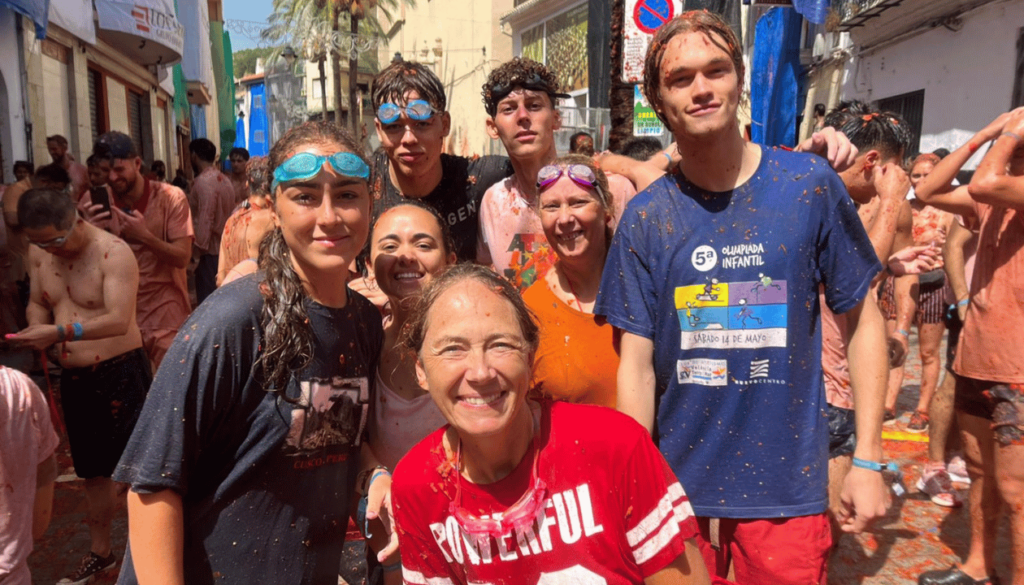

Thinking about celebrating La Tomatina but feeling unsure because you don’t know the people, culture, or places? It’s not just you.
Many travellers dream of joining Spain’s biggest food fight but hesitate for lack of inside knowledge. I’m Pilar, a native host teacher with Spanish Express, and I’ve welcomed students from around the world to live this unique adventure.
In this blog, I’ll share everything you need to know about La Tomatina – its history, traditions, what happens on the day, and how you can experience it like a local through our Spanish Homestay Immersion Program (SHIP).
What is La Tomatina, Spain’s Famous Tomato Festival?
La Tomatina is a legendary tomato festival in Spain where thousands gather for the world’s biggest food fight. It takes place in Buñol, a small town in the province of Valencia, Spain. Every year, on the last Wednesday of August, the town’s streets become rivers of red as participants joyfully engage in an epic tomato fight. For one hour, people throw squashed, overripe tomatoes at each other just for fun. There are no winners or losers, only a hilarious mess and lots of laughter.
La Tomatina is one of Spain’s most famous festivals, celebrated for its unique and playful spirit. As one of Spain’s most unique festivals, it stands out among other famous festivals like San Fermín’s Running of the Bulls and Las Fallas, showcasing the diversity and excitement of Spain’s festivals.
This Spanish fiesta has no deep religious significance, unlike many other fiestas; it’s purely about fun and community. In fact, La Tomatina is now so popular that it’s recognized as the largest tomato-throwing battle in the world, drawing visitors from all over the globe.

When and where does La Tomatina take place? The festival takes place in Buñol’s town square and surrounding streets, and is held annually on the last Wednesday of August each year. Festivities usually start around 10 AM, and the actual tomato fight kicks off at about 11 AM, lasting until noon (about one hour long).
Buñol is a small town of around 9,000 residents, but during La Tomatina, the town swells with up to tens of thousands of participants. In recent years, the event has been a ticketed event to cap attendance at around 20,000 people, ensuring safety and that the streets and infrastructure can handle the crowd.
Why Do They Celebrate La Tomatina? – History & Origins
You might be wondering, why on earth did a town start throwing tomatoes at each other? The history of La Tomatina is a bit messy (pun intended), and several popular theories circulate. The most widely accepted origin story is that the festival started in 1945. During a carnival parade or town celebration (some say it was in honor of the town’s patron saints, like San Luis Bertrán and the Virgin Mary in late August), a group of young people got into a playful scuffle in the town square. The la tomatina start was marked by this informal altercation, which escalated into a spontaneous tomato fight when they grabbed tomatoes from a nearby vegetable stall and began throwing tomatoes at each other. The town had never seen such a battle of produce!
That first tomato fight was spontaneous and chaotic. The following year, those youths intentionally brought overripe tomatoes from home and started a tomato battle again, kicking off the tradition. As more locals joined in, the food fight became an annual event. However, not everyone was amused by this messy new tradition at first. City council and authorities weren’t too pleased with the disorder. In the early 1950s, during Spain’s conservative era under Francisco Franco, La Tomatina was banned due to having no religious significance. (General Franco didn’t appreciate a giant veggie battle with no religious or official purpose.) But Buñol’s locals protested – they loved their new tomato fling! They even held a tongue-in-cheek “tomato funeral” in 1957, carrying a coffin with a giant tomato through the streets as a symbol of their grief over the ban.
The protest worked. The ban was lifted in 1959, and La Tomatina became an official town festival again – this time with the city itself helping organize it. Over the decades, the festival grew larger and gained fame throughout Spain (it even got TV coverage in the 1980s). In 2002, La Tomatina was declared a Fiesta of International Tourist Interest – a big honor recognizing that people from around the world were interested in this Valencian tomato extravaganza. Today, this tomato fight is not just a quirky local tradition but a globally renowned event. And while there’s no religious significance or deeper meaning, that’s precisely the point – it’s celebrated simply for fun and community spirit.
(What about those other origin stories?) Aside from the main tale above, people in Buñol like to joke about other possible origins. One popular theory claims La Tomatina began when angry crowds threw tomatoes at a bad musician during a carnival parade in the 1940s. Another story suggests it started as a juvenile class war or a protest where young folks hurled tomatoes at authority figures (like the mayor) to voice their discontent. These stories are difficult to verify – and during the 1940s, with war and political turmoil, randomly wasting food like tomatoes would have been unusual. Nonetheless, whatever the true origin, one thing is clear: the people of Buñol embraced the tomato toss and made it their own.

What Happens During La Tomatina Festival?
On the morning of La Tomatina, excitement fills the air in Buñol. Festivities begin a few hours before the big tomato fight. One traditional event to kick off the morning is the palo jabón, the “greased pole” contest. In the town center, locals set up a tall wooden pole coated in slippery soap (hence “greased”), with a meaty prize – usually a Spanish ham – hung at the top. Brave participants try to climb the pole to knock down the ham. It’s a hilarious sight: people shimmy up, slip down, and the crowd (including many tourists and locals) sing and cheer them on. Whether someone gets the ham or not, after a while the real highlight of the day approaches.
Around 11:00 AM, a loud shot (usually a water cannon or firework) signals the start of the tomato fight. This is when the trucks loaded with tomatoes roll in. Huge trucks carry tons of overripe tomatoes (that are too squishy to sell for eating) into the middle of the town. Each truck unloads its cargo at different points along the route, adding to the excitement and chaos as tomatoes are dumped in multiple locations for participants to grab. How many tomatoes are we talking about? Approximately 150,000 tomatoes (around 40 to 50 metric tons) get tossed around during the event. Yes, that’s right – literally more tomatoes than you can imagine are dumped into the streets, turning Buñol into a sea of red goo. The crowd of participants, dressed in old clothes and often with goggles, dive in to grab tomatoes and start throwing them at anyone and everyone.
For the next hour, pure pandemonium reigns (in a fun way!). You’ll be laughing, dodging, and splattering friends and strangers alike with tomato pulp. It’s common to see people completely covered from head to toe in tomato mush – hair, clothes, and all. Some revelers even swim in the tomato juice that accumulates on the roadway. Remember, it’s all in good fun – people are friendly amid the chaos, and if you fall or drop your stash of tomatoes, someone might even hand you another tomato to keep you in the game.
Exactly one hour later, at noon, a second starter pistol shot rings out to signal the end of the fight. Instantly, everyone stops throwing tomatoes (rules are rules!). What does the town look like after 60 minutes of tomato mayhem? In a word: red. The streets, buildings, and people are drenched in tomato paste. The entire town square looks like the aftermath of a sauce explosion. But the cleanup begins almost immediately. Buñol has the post-fight cleaning process down to a science. Fire trucks spray down the streets with hoses, using water drawn from an old Roman aqueduct nearby. The torrent of water helps wash away the mountains of tomato pulp. Locals often join in, opening up hoses or buckets for soaked participants to rinse off. In fact, a fun trivia: the acidity of tomato juice aids in the cleaning process, resulting in some of the town’s surfaces being cleaner after being rinsed off than they were before the event!
By mid-afternoon, Buñol is transformed from a tomato battlefield back to normal city streets – as if the wild tomato war never happened. Of course, the memories (and countless photos) live on. After cleaning up, participants usually celebrate their survival with a well-earned meal, a drink, and perhaps a nap! (In the Valencian region, it’s common to have a giant paella cook-up or continue the party in the evening – the fun doesn’t end at noon.)
The Start of the Festival – How the Tomato Battle Begins
The excitement in Buñol is palpable as the La Tomatina festival kicks off in the heart of the town square. On the last Wednesday of August, locals and visitors gather early, buzzing with anticipation for what’s about to become the world’s biggest food fight. The city council oversees the proceedings, ensuring everything is set for a safe and unforgettable event.
The official start of La Tomatina is marked by the legendary palo jabón—a tall, greased pole with a meaty prize (usually a Spanish ham) perched at the top. As the crowd cheers, brave participants attempt to climb the slippery pole, slipping and sliding in hilarious fashion. The moment someone finally claims the meaty prize, the festival’s energy reaches a fever pitch.
But the real signal that the tomato fight is about to begin is when the trucks loaded with overripe tomatoes arrive, rolling into the town square. The crowd of La Tomatina attendees surges with excitement, knowing that the main event is moments away. With a blast from the starter cannon, the La Tomatina festival officially erupts into a sea of red, as thousands prepare to throw, dodge, and laugh their way through this iconic Spanish festival. What started as a small-town tradition in 1945 has grown into a ticketed event that draws people from all over the world, eager to be part of this unique celebration.
Food Fight Madness – The Sights, Sounds, and Sensations
As soon as the starter cannon sounds, the streets of Buñol explode into a wild, joyful chaos. The La Tomatina festival transforms the town into a living, breathing carnival parade, with overripe tomatoes flying through the air in every direction. Young people, locals, and visitors alike dive into the action, scooping up tomatoes from the ground and hurling them at friends and strangers. For one hour, the town is united in the purest form of food fight fun.
The sheer scale of the tomato fight is staggering—how many tomatoes are thrown? Over 150,000 kilograms! The air is thick with the scent of tomatoes, and the laughter of participants echoes off the ancient buildings. The tradition of squashing the tomatoes before throwing them keeps things safe, as hard objects are strictly forbidden. The streets quickly become slick with red pulp, and everyone is soon drenched from head to toe.
The festival’s playful spirit is rooted in its history, with some saying it began as a juvenile class war or a spontaneous act during a carnival parade. Today, the event honors the town’s patron saints, Luis Bertran and the Virgin Mary, but above all, it’s about community, joy, and letting loose. The greased pole and meaty prize add to the spectacle, making La Tomatina a truly unforgettable event for all who take part.
Rules and How to Stay Safe in the Tomato Battle
Even though the tomato fight is basically a huge free-for-all battle of tomatoes, there are important rules in place to keep it safe and enjoyable for everyone. The Buñol city council has a short list of rules for the event that all participants are expected to follow:
- Only tomatoes can be thrown: Don’t bring or throw any hard objects or other items that could hurt people. (It’s a tomato fight, not a rock fight!)
- Squash the tomatoes before throwing them: This is to make sure they are soft and no one gets hurt by a hard tomato. A squeezed tomato = a safer projectile.
- Don’t tear or throw T-shirts: In the past, some rowdy participants would rip others’ shirts as a prank. That’s a no-go now – keep your and others’ clothes intact. (You’ll want some sort of shirt on anyway to protect your skin from sun…and sunburn covered in tomato doesn’t sound fun.)
- Keep a safe distance from trucks: During the event, several large trucks deliver the tomatoes and move slowly through the crowd. Make way for them and don’t clamber onto the trucks. Stay safe and let the trucks do their job.
- Stop when it’s over: The moment you hear the second gunshot or signal, stop throwing tomatoes. One hour is the limit. After that, it’s cleanup time, not fight time.

Security staff and local volunteers are present to enforce these guidelines, and really, following them ensures everyone has a great time without injuries. Beyond the official rules, here are some tips if you’re planning on attending La Tomatina:
- Wear old clothes: Ideally wear something you don’t mind ruining (and probably throwing away afterward). Many people wear white T-shirts to show off the tomato splatter, but trust us, that shirt will never be white again!
- Wear goggles or protective eyewear: Tomato juice in the eyes can sting. A simple pair of swim goggles can save you a lot of squinting. (Plus, it makes you look extra prepared for the tomato tsunami.)
- Wear secure, closed-toe shoes: The streets get extremely slippery with tomato pulp. You’ll be doing a lot of moving (and maybe the occasional playful shoving). Flip flops or loose sandals can easily come off or cause you to slip, so wear old sneakers or shoes that you can tie. Some folks tape their shoes to their feet to avoid losing them in the carnage.
- Protect your valuables: You really shouldn’t carry anything that can be damaged by water or tomatoes. If you want to take photos, use a waterproof camera or phone pouch. Better yet, just soak in the experience with your own eyes and save the pictures for before/after the fight.
- Plan for cleanup: Have a plan for how you’ll clean yourself after. Locals often set up public hoses, and many head to the river or public showers. Bring a change of clothes (and maybe a bag for your tomato-soaked ones). You’ll be surprised how clean you feel once you wash off – the tomatoes leave your skin feeling soft!
Remember, this event is about having ridiculous fun and nobody is trying to hurt anyone. As long as you follow the rules and use common sense, you’ll have an amazing time in this giant food fight.
Attending La Tomatina – Tickets, Timing, and Travel Tips
Originally, anyone could just show up to La Tomatina and join the fun for free. However, as its popularity exploded, Buñol had to introduce crowd control for safety. Since 2013, La Tomatina is a ticketed event. Only around 20,000 tickets are available each year (sometimes a few thousand more) even though demand is much higher. This limit keeps the crowd to a manageable size for the town. How much is a Tomatina ticket? Generally, a basic entry ticket costs around 12€ (about $12-15) if purchased officially. This simply grants you access to the tomato fight area. There are also package deals (ranging up to 40-50€ or more) that can include extras like round-trip transportation from Valencia, locker facilities to store your things, a t-shirt, goggles, or entry to the post-fight pool party. It’s wise to buy your ticket online from the official La Tomatina site or a trusted tour provider well in advance, as they can sell out.
When to arrive: On the day of the festival (last Wednesday of August), arrive in Buñol early in the morning. The town’s streets get packed and access roads close when the tomato trucks are coming in. Many people catch the first morning trains or buses from Valencia (the nearest big city) around 6 or 7 AM to ensure they get in before crowds and road closures. Expect the town to be very crowded – thousands of excited people from all over the world fill the streets, singing, wearing costumes or goggles on their heads, and gearing up for the fight.

Where to stay: Buñol is a very small town with limited accommodations. Most visitors choose to stay in Valencia city (about 38 km away) and travel to Buñol just for the festival. Valencia has plenty of hotels/hostels and it’s an easy trip by train or bus (about 45 minutes to 1 hour journey). If you’re staying with Spanish Express (more on that below!), you’ll actually live in Valencia with a local host and have your transportation to Buñol arranged as part of the program.
Other tips for attending La Tomatina:
- The night before La Tomatina, get a good rest (if you can contain your excitement). Some people party, but remember you’ll be exerting yourself a lot in the hour of the fight under the sun.
- In the week leading up, Buñol has other festivities too – like parades, music, and even a paella cooking contest. If you go with a guided group, you might explore those as well.
- After the tomato fight and initial rinse, join the locals in post-fight celebrations. Often there’s an after-party or just informal gatherings where you can grab some food and drinks. August in Spain is hot, so a cold drink after being pelted with tomatoes feels heavenly!
After the Festival – Cleanup, Celebrations, and Local Life
When the final cannon blast signals the end of the tomato fight, the streets of Buñol are a vivid sea of red. But the fun doesn’t stop there—the legendary cleaning process begins almost immediately. Fire trucks roll in, spraying down the streets with powerful hoses, while locals and city workers join forces to wash away the tomato pulp. The teamwork between residents and La Tomatina attendees is a testament to the town’s community spirit.
Participants, still wearing their old clothes and t-shirts stained with tomato juice, gather to celebrate their survival and share stories of the day’s madness. The town comes alive with post-festival festivities and events, from lively gatherings in the town square to delicious meals and music. Many head to nearby Valencia for a well-deserved rest, as the city offers plenty of accommodation options for those who traveled for the Spanish festival.
Though La Tomatina was once banned for lacking religious significance, it has become a cherished part of Spain’s cultural heritage. As the last Wednesday of August draws to a close, Buñol is already looking forward to next year’s celebration—proving that the spirit of La Tomatina lives on in every tomato-stained street and smiling face.
Immerse Yourself in La Tomatina with Spanish Express (A Unique Trip for Spanish Learners)
Now, imagine not just visiting La Tomatina, but also learning Spanish and diving into Spanish culture at the same time. With Spanish Express, you can do exactly that! 🎉 As your host teacher in Valencia, I’m Pilar, and I invite you to join me for an unforgettable week-long Spanish immersion course centered around La Tomatina. This is not your typical classroom experience – it’s a full cultural and linguistic adventure timed perfectly for the festival.

Embark on a Spanish Adventure Unlike Any Other:
- Complete Spanish Immersion: Live in a Spanish home (my home!) for one week and practice Spanish every day. From breakfast conversations to guided excursions, you’ll be surrounded by the language. This isn’t just learning from a book – you’ll be using Spanish in real-life situations constantly, which is the best way to become truly fluent.
- Dive Deep Into Spanish Traditions: During this special week, you’ll learn all about Valencia’s culture and traditions. We’ll explore Buñol’s history and discover why the tomato is so important (did someone say gazpacho? 🍅). You’ll visit the La Tomatina Museum in Buñol to see how the festival evolved. We’ll also tour Valencia’s iconic sites, like the City of Arts and Sciences and the beautiful Albufera lake, giving you a taste of Spain beyond the tomatoes.
- Enhance Your Communication Skills with a Native Teacher: I will be your personal guide and teacher throughout. Every day, we’ll have integrated Spanish classes (about 25+ hours over the week) tailored to your level, focusing on conversation and practical usage. Then, we immediately put it into practice as we go about our activities. It’s like a language bootcamp mixed with a holiday – you’ll be amazed how quickly your speaking confidence grows when you’re ordering tapas or chatting with locals at the market.
- Enjoy Authentic Spanish Cuisine and Hospitality: Staying with me means you’ll also get home-cooked Spanish meals and a family-like environment. We’ll enjoy authentic paella (Valencia’s famous rice dish) – in fact, after surviving the tomato fight, we’ll celebrate with a delicious paella lunch as is local tradition! You’ll also try Spain’s famous tapas, and maybe even learn to cook a dish or two. 😋
What’s included in this La Tomatina Language & Culture Week:
- 7 days/6 nights accommodation in Valencia (in your teacher’s home).
- Daily Spanish lessons (adapted to your level, at least A2 level is recommended so you can fully participate in conversations).
- All meals and local transportation for activities. We’ll either dine at home with traditional recipes or head out to my favorite local spots.
- Daily themed activities and excursions: These include a guided tour of Buñol to discover the origin of La Tomatina, attending the actual Tomatina festival together (with all the logistics taken care of), a visit to the Central Market of Valencia to learn about regional produce (and grab some tasty treats), a cycling tour through the Turia River Gardens to the modern architectural marvels of Valencia, and a tranquil boat ride in the Albufera natural park. Each activity is a chance to practice Spanish in context and learn cultural insights.
- Airport transfers: You’ll be picked up from Valencia airport when you arrive and dropped off when the program ends – no worries about finding your way.
- Plenty of support and guidance: I (and Spanish Express) will be with you every step, from helping you prepare for the trip, to coaching you during the week, to answering any questions you have. By the end, you’ll feel like part of the family!
Sound exciting? It truly is. One of our students, Liam, joined this program last year and said: “I didn’t just attend La Tomatina, I lived it. Pilar made every day an adventure – from learning quirky Valencia phrases over breakfast to singing along with locals during the festival. I came back home with memories of the tomato fight of course, but also with much more confidence in speaking Spanish and a deep appreciation for Spanish culture.”
I have to say, students come back very happy (and yes, a bit tired – we pack a lot into a week 🙂). It’s a blast for me as well, because each student brings their own perspective and enthusiasm. We truly immerse ourselves in language and culture. And don’t worry, we balance fun and learning – after all, I want you to enjoy this like a holiday and see progress in your Spanish fluency.
Requirements: This immersive experience is best suited for Spanish learners with at least an intermediate level (around B1). That way, you’ll be able to follow along in Spanish as we go (and I promise, your level will jump by the end!). Before the trip, we’ll have a Zoom meeting to assess your speaking skills and get to know each other. You should be open-minded and ready to make friends with fellow students from different countries. The key is that during the program we only speak Spanish – a full idiomatic immersion. It might sound challenging, but it’s the fastest way to think in Spanish. And don’t worry, I’ll be there to help you every moment. All you need is a passion for adventure and a willingness to try something truly unique!
Ready to make this the year you celebrate the tomato festival not as a tourist, but as an insider? 🎊
Book this adventure today! Spaces are limited because we keep the group small for quality. If you’re interested, get in touch and learn more about how you can join our La Tomatina Week.
¡Hola! You surely want to know more about this opportunity. We will contact you and explain everything you need to know about this amazing way to experience idiomatic tourism in Spain!
Name
Email
Mobile number
Spanish Level
You’ll be greeted by one of our Program Coordinators, and they’ll set up a meeting where you can ask all the questions you want.
FAQs
When and where is the tomato festival in Spain?
The famous tomato-throwing festival, La Tomatina, is held in Buñol, a small town near Valencia, Spain. It happens on the last Wednesday of August each year, with the tomato fight usually starting around 11 AM and lasting one hour.
Why do they celebrate the tomato festival?
La Tomatina is celebrated just for fun! It started accidentally in the 1940s (most say 1945) during a town celebration when a playful fight broke out and people began throwing tomatoes. It became an annual tradition simply because everyone enjoyed it. There’s no religious or political reason – it’s all about community, joy, and doing something crazy and different to celebrate the town’s fiesta.
What are the 5 rules of La Tomatina?
The five key rules are: 1) Only throw tomatoes (no other objects), 2) Squash tomatoes before throwing them (for safety), 3) Don’t tear or throw clothing (no ruining t-shirts!), 4) Keep your distance from trucks, and 5) Stop throwing tomatoes as soon as the second signal sounds (when the hour is up. Following these rules ensures a safe and fun festival for everyone.
How many tomatoes are thrown at La Tomatina?
A huge amount – about 150,000 tomatoes on average are thrown. That’s roughly 40 metric tons of tomatoes (or around 320,000 pounds) in a single hour of mayhem! The tomatoes used are overripe and otherwise would be trash, so they make the perfect ammo for a massive food fight.
How much does it cost to get into La Tomatina?
Basic entry tickets cost around 12€ if bought from the official source. This just gets you into the festival area. If you opt for packages (with extras like transportation from Valencia, goggles, or after-parties), it can cost more, anywhere from 30€ to 100€ depending on what’s included. Remember, you must buy your ticket in advance since the event has limited capacity.
Why was La Tomatina banned in the 1950s?
It was temporarily banned by the authorities (under the Franco regime) in the early 1950s because it was seen as lacking religious significance and causing public disorder. Locals continued to secretly hold tomato fights despite the ban, and even protested by holding a symbolic “tomato funeral” in 1957 to demand the festival’s return. The pressure worked, the ban was lifted, and La Tomatina returned officially in 1959.
What happens to all the tomatoes after the fight?
Cleanup begins right after the tomato fight ends. Fire trucks hose down the streets with water (sourced from a Roman aqueduct) to wash away the tomato pulp. Volunteers and city workers sweep up the tomato mush. Amazingly, the citric acid in the tomatoes helps disinfect and clean the streets, so Buñol ends up quite clean after all that washing. The tomato waste is generally rinsed off into the town’s drainage system or collected to be composted.
Join us in Buñol this summer and experience La Tomatina for yourself – it’s the messiest, craziest, and most memorable festival you’ll ever attend. And with Spanish Express, you won’t just be a tourist; you’ll be a participant in Spanish life, language, and culture. ¡Te esperamos! 🇪🇸🍅
Conclusion and Recap
In summary, the La Tomatina festival is a one-of-a-kind food fight that brings together thousands of La Tomatina attendees from around the globe to the small town of Buñol, Spain, every last Wednesday of August. With its rich history and vibrant tradition, this ticketed event has grown into the biggest food fight in the world, overseen by the city council and fueled by the energy of young people and locals alike. The thrill of the tomato fight, the spectacle of overripe tomatoes flying through the air, and the camaraderie of the cleaning process and celebrations make La Tomatina an unforgettable Spanish festival.
Whether you’re attending La Tomatina for the first time or returning for another round of food fight fun, you’ll be part of a tradition that’s as much about joy and community as it is about tomatoes. So, mark your calendar for the last Wednesday of August, grab your old clothes, and get ready to join the world’s most exhilarating tomato fight—an experience you’ll remember for a lifetime!

